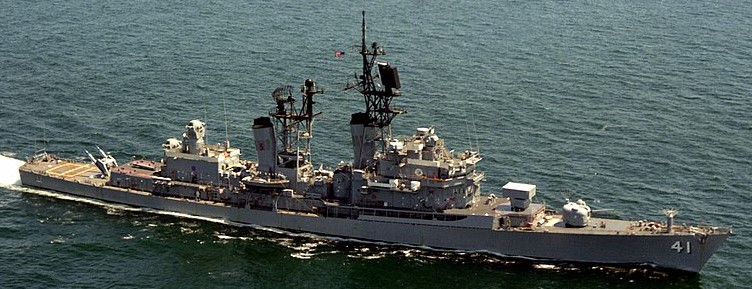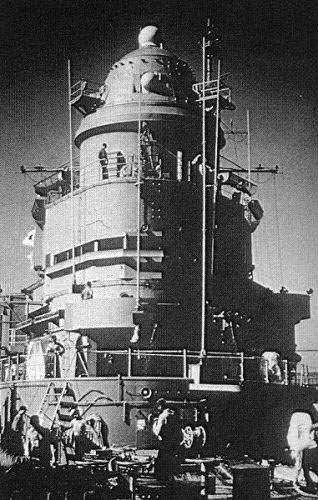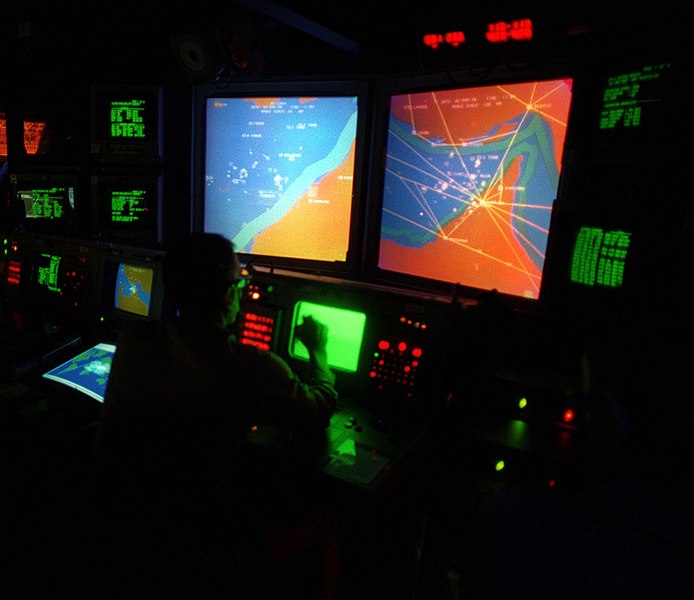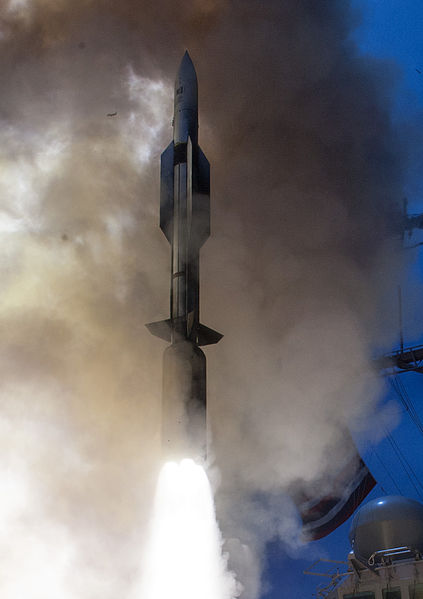I’ve mentioned Aegis several times, but haven’t really explained what it is. As it, and systems like it, are very important parts of modern naval warfare, this is a gap I intend to rectify.

Aegis destroyer USS Wayne E Meyer at LA Fleet Week 20161
During WWII, navies realized that the increasing performance of airplanes, and the development of guided missiles, would render guns obsolete as air-defense systems. They began to develop missiles as an alternative, although none reached service before the mid-50s. The US 3T family – Talos, Terrier and Tartar – is a good cross-section of these early missiles. These early missiles had much greater envelopes than the guns they replaced, but they weren’t perfect by any stretch of the imagination. Targets were acquired by rotating radars, which would take several seconds to complete a search. Each missile required a dedicated illuminator to provide the signal it homed in on. Due to electronic interference, only two illuminators could be installed on each end of the ship.2 Due to the limited accuracy of early missiles, two missiles were fired at each target, limiting a ship to no more than maybe 8 missiles in the air at once. In theory, it should be able to fire about two missiles/launcher/minute, but in practice it was usually limited by guidance channels. Long-range missiles might be able to get off 10 salvos/end, more normal systems about half that. So a heavy escort could kill maybe 20 targets, a normal one 5-10, assuming that the missiles actually worked.

USS King (DDG-41), a Terrier ship
This was obviously inadequate when facing heavy missile attack, so in the late 50s the US drew up plans for a system called Typhon. It would replace the 3-T with a new family of missiles, but the real key was the replacement of the old radars. Instead, Typhon would use the SPG-59 radar, which merged the air search and missile guidance radars into one. Now, the radar would receive signals from the missiles, calculate an intercept course, and pass it back to the missile. Unfortunately, it was well ahead of its time, and the whole program was cancelled in 1963 due to spiraling cost.

SPG-59 radar on test ship Norton Sound
However, the threat of Soviet saturation attacks had only gotten worse, and a replacement program was started, the Advanced Surface Missile System. ASMS was renamed Aegis in 1969, and the first test system went to sea in 1973. However, the problems weren’t over. The initial attempts to send Aegis to sea on a nuclear cruiser failed, and the US ended up building the cheaper Ticonderoga class. The lead ship commissioned in 1983, and ushered in a revolution in naval air defense.
USS Ticonderoga at sea
Let’s compare Aegis to the previous system. The main radar is the SPY-1 phased-array. It's electronically scanned, which means that the array is fixed and looks in different directions using electronic witchcraft. This gives it the capability to search practically instantly across the whole area around the ship, and provide much more precise tracks. The Standard missiles it uses have autopilots, which are updated by radio from the ship. The SPY-1 is accurate enough to get them very close before they have to lock on to the target, so they only need an illuminator for the last few seconds of flight.3 The missiles are fired from a vertical launch system, which means that the rate of fire is now a missile every second or two per end.4 Now a ship can take out one target per end every 10 seconds or less, regardless of range. Oh, and the modern missiles are more accurate than the old ones, too. A Ticonderoga has four illuminators, while the more recent Arleigh Burkes have three. Today, all of our major surface warships have Aegis, with the exception of the three Zumwalts.5

Displays in the CIC6 of USS John S McCain
All of this is handled by the Weapon Control System, but the real heart of Aegis is the Command and Decision (C&D) system. This system is capable of keeping track of more than a hundred targets in an area over a hundred nautical miles across,7 sharing tracks with other units nearby, and even has the capability to engage targets that look threatening, subject to operator veto. Previous systems gave the command staff much more limited situational awareness, and the improved picture has proven valuable, to the point that Aegis ships have been deployed when other air control assets were unavailable.

Aegis BMD test on USS Lake Erie
When the US decided to send missile defense to sea in the 1990s, Aegis was the obvious choice to use as a base. As such, some of the cruisers and destroyers have been refitted with more powerful radar and new software to support the BMD operations that I’ve described elsewhere. Development on this is continuing, with Aegis moving to an Open Architecture system to allow it to take advantage of improvements in civilian computers, and new features being added every few years for both air and missile defense.

CEC-enabled SM-6 missile
One of the most notable of these is the Cooperative Engagement Capability (CEC). This is a system that allows ships and aircraft to share fire-control quality data. This means that a cruiser or destroyer could launch at targets it can't see, on the basis of data from, say, an E-2 Hawkeye AWACS aircraft. The missiles involved are fitted for active homing, so the ship doesn't need line of sight in the endgame either, and it's not limited by the number of illuminators it has. This has only entered service recently, but it promises to make another major increment in defensive performance.
Aegis is at the core of the revolution in naval air defense that has taken place over the past few decades. It's allowed the USN to face missile attacks with much greater confidence, enter the field of ballistic missile defense, and has been exported to a number of allies. Aegis itself has been proved in the clashes in the Red Sea, and it is clear that similar systems are vital for protecting ships from missile attack in the future.
1 Author's photo. Interestingly, Meyer is named after Rear Admiral Wayne E. Meyer, the manager of the Aegis project for 13 years. ⇑
2 Some ships were single-ended, others double-ended. Each missile end usually had a twin launcher. Single-ended ships had guns, ASW weapons, and/or a helicopter pad on the other end. ⇑
3 Note that the autopilot also means that you can fly a more energy-efficient trajectory, approximately doubling range. ⇑
4 The first five Ticonderogas had Mk 26 twin-arm launchers instead, but they were retired in the mid-2000s. ⇑
5 During the late 80s, some of the previous generation of ships were upgraded with what was called New Threat Upgrade (NTU). This involved incorporating the autopilot system on ships with old-style illuminators and radars. It increased their track-handling capability significantly, though not to the same extent as Aegis. One of the main reasons was that SPY-1 produces a track accurate enough to point the illuminator directly, and in fact Aegis illuminators are transmit-only, while NTU ships still had to search for targets with theirs. All of these ships were retired during the 1990s. ⇑
6 Combat Information Center ⇑
7 These numbers are from the USN, and I’d guess that the actual numbers are at least twice this. The capabilities of this kind of system are usually closely guarded. For instance, the USN still only admits to "25+ kts" for its submarines, when the actual number is somewhere north of 30. ⇑

Recent Comments